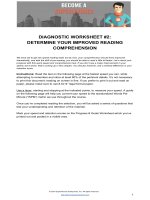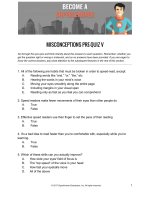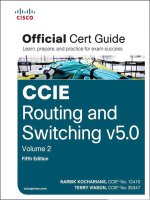094 JPA entity relationships kho tài liệu training
Bạn đang xem bản rút gọn của tài liệu. Xem và tải ngay bản đầy đủ của tài liệu tại đây (270.57 KB, 13 trang )
JPA Entity Relationships
Types of Relationships
•
One to One - @OneToOne
•
•
One entity is related to one other entity
One to Many - @OneToMany
•
One entity is related to many entities (List, Set,
Map, SortedSet, SortedMap)
Types of Relationships
•
Many to One - @ManyToOne
•
•
The inverse relationship of One to Many
Many to Many - @ManyToMany
•
Many entities are related to many entities
•
Each has a List or Set reference to the other
•
A join table is used to define the relationships
Unidirectional vs Bidirectional
•
Unidirectional is one-way
•
•
Mapping is only done one way. One side of the
relationship will not know about the other
Bidirectional is two way
•
Both sides know about each other
•
Generally recommended to use Bidirectional, since you
can navigate the object graph in either direction
“Owning Side”
•
The Owning side in the relationship will hold the
foreign key in the database
•
One to One is the side where the foreign key is
specified
•
OneToMany and ManyToOne is the ‘Many’ side
•
‘mappedBy’ is used to define the field with “owns” the
reference of the relationship
Fetch Type
•
Lazy Fetch Type - Data is not queried until referenced
•
Eager Fetch Type - Data is queried up front
•
Hibernate 5 Supports the JPA 2.1 Fetch Type Defaults
•
JPA 2.1 Fetch Type Defaults:
•
OneToMany - Lazy
•
ManyToOne - Eager
•
ManyToMany - Lazy
•
OneToOne - Eager
JPA Cascade Types
•
JPA Cascade Types Control how state changes are cascaded
from parent objects to child objects.
•
JPA Cascade Types:
•
PERSIST - Save operations will cascade to related entities
•
MERGE - related entities are merged when the owning entity
is merged
•
REFRESH - related entities are refreshed when the owning
entity is refreshed
JPA Cascade Types - Cont
•
•
JPA Cascade Types (continued):
•
REMOVE - Removes all related entities when the
owning entity is deleted
•
DETACH - detaches all related entities if a manual
detach occurs
•
ALL - Applies all the above cascade options
By default, no operations are cascaded
Embeddable Types
•
JPA / Hibernate support embeddable types
•
These are used to define a common set of properties
•
For example, an order might have a billing address,
and a shipping address
•
An embeddable type could be used for the address
properties
Inheritance
•
MappedSuperclass - Entities inherit from a super class. A
database table IS NOT created for the super class
•
Single Table - (Hibernate Default) - One Table is used for all
subclasses
•
Joined Table - Base class and subclasses have their own
tables. Fetching subclass entities require a join to the
parent table
•
Table Per Class - Each subclass has its own table
Create and Update Timestamps
•
Often a best practice to use create and update
timestamps on your entities for audit purposes
•
JPA supports @PrePersist and @PreUpdate
which can be used to support audit timestamps
via JPA lifecycle callbacks
•
Hibernate provides @CreationTimestamp and
@UpdateTimestamp









